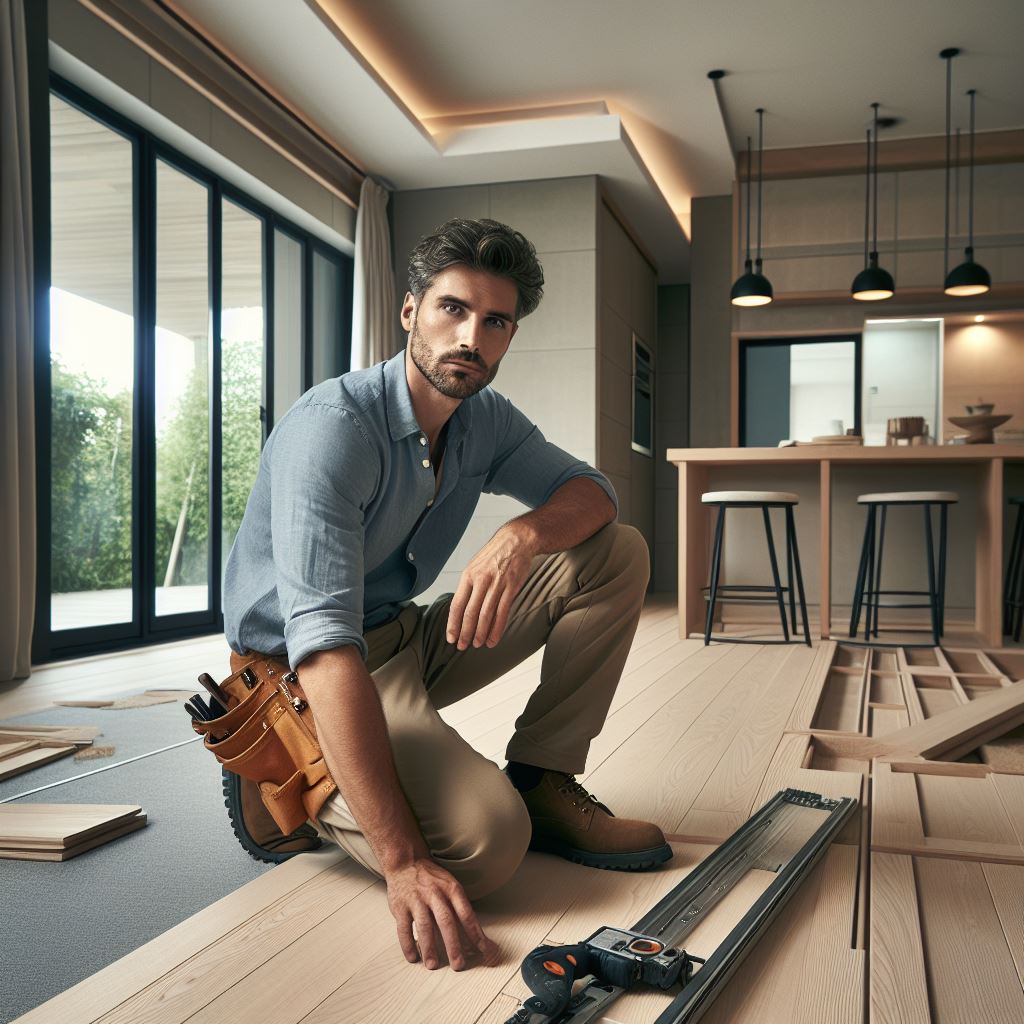Floating wood floors have rapidly become a favorite in home renovations across the U.S. These innovative flooring systems offer a modern and practical solution for homeowners and professionals alike. Their ease of installation and versatile nature make them ideal for a wide range of renovation projects.

Understanding Floating Wood Floors
At its core, a floating wood floor consists of planks that are connected to each other, either by glue or a unique locking system, but not attached to the subfloor. This design allows the floor to ‘float’ above the surface beneath it.
Compared to traditional hardwood floors, which are nailed or glued down, floating wood floors offer a different approach. They are less permanent, more adaptable, and can be installed over various types of existing floors. The options here include laminates, which are synthetically manufactured to mimic wood, and engineered hardwood, which combines a real wood veneer with a plywood or fiberboard base for added stability.
Advantages
- Ease of Installation: The process of installing floating wood floors is straightforward, making it a popular choice for DIY enthusiasts. The planks typically snap or glue together, creating a continuous surface that doesn’t require the complex tools or techniques of traditional flooring.
- Cost-Effectiveness: Floating wood floors can be more economical than traditional hardwood floors. The materials are often less expensive, and the ease of installation reduces labor costs, whether you’re hiring a professional or doing it yourself.
- Durability: Despite their name, floating wood floors are sturdy and resilient. They are designed to withstand daily wear and tear, making them suitable for high-traffic areas.
- Versatility in Different Climates: These floors can adapt to various environmental conditions. They are less prone to warping or shifting in response to changes in humidity and temperature than traditional hardwood, making them suitable for a wide range of climates.
- Compatibility with Underfloor Heating: Floating wood floors can be a good match for homes with underfloor heating systems. Their construction allows for efficient heat transfer and expansion, enhancing the comfort of your living space.

Choosing the Right Floating Wood Floor
In the realm of floating wood floors, the key is selecting the right type for your specific needs. This decision is influenced by several factors:
- Room Usage and Foot Traffic: Assess the area where the flooring will be installed. High-traffic zones like family rooms or hallways require durable options, such as thicker laminates or robust engineered hardwoods.
- Moisture Levels: In rooms prone to moisture, like kitchens and bathrooms, your choice should lean towards moisture-resistant materials. Engineered hardwoods are typically favored in these settings due to their dimensional stability.
- Aesthetics vs. Practicality: While the appearance of the flooring is important, practical considerations should not be overlooked. Darker floors, for instance, might require more frequent cleaning. Choose a floor that not only complements your home but also fits your lifestyle.
- Quality of Materials: Investing in higher-quality materials pays off in the long run. For engineered hardwoods, a thicker wear layer equates to greater longevity and resilience.
Preparation for Installation
Proper preparation is the foundation of a successful installation:
- Tools and Materials: Essential tools include a tape measure, circular saw or floor cutter, spacers, hammer, tapping block, and pull bar. An appropriate underlayment is also crucial for a smooth installation process.
- Preparing the Subfloor: The subfloor must be clean, level, and dry. Any high spots should be sanded down and low spots filled. Conducting a moisture test, particularly over concrete, is advisable to determine if a moisture barrier is needed.
- Measuring and Planning: Accurate room measurements are critical for planning the layout. It’s important to consider the direction of the planks and to plan for a balanced appearance, avoiding small slivers of flooring at the room’s perimeter.
Step-by-Step Guide to Installation
A methodical approach to installation ensures a professional result:
- Laying the First Row: Begin in a corner, using spacers to maintain an expansion gap. This gap is crucial for allowing the floor to expand and contract with temperature and humidity changes.
- Clicking Planks Together: Floating floors often feature a click-lock system. Align the new plank at an angle to the existing one and gently click into place, using a tapping block and pull bar to secure the fit.
- Staggering Seams: Ensure the seams are staggered between rows. This not only enhances the floor’s aesthetic appeal but also contributes to its structural integrity. A stagger of at least 6 inches is recommended.
- Cutting and Fitting: Measure and cut planks to fit the room dimensions, always allowing for the expansion gap. For irregular shapes, a cardboard template can be a useful guide.
- Troubleshooting: If issues arise, such as a plank not fitting snugly, inspect for debris in the groove. Uneven underlayment can cause a floor to feel bouncy and should be addressed for a stable installation.

Maintenance and Care
Proper maintenance is essential to extend the life and beauty of your floating wood floors.
- Daily Maintenance Tips: Regular cleaning is paramount. Sweep or vacuum the floor frequently to remove dirt and grit. For spills, promptly wiping them up is crucial to prevent water damage. Entrance mats can significantly reduce the amount of dirt tracked onto the floor.
- Dealing with Scratches and Damage: For minor scratches, wood putty or color-matched markers can effectively conceal them. Deeper scratches may require more specialized repair kits, specifically designed for your floor type.
- Long-Term Care and Replacement: Periodic assessment of your floor’s condition is important. Signs of wear, such as fading or persistent stains, might indicate the need for replacement. Some floating floors can be refinished, but this depends on the thickness of the wood layer in engineered flooring.
Innovations and Trends in Floating Flooring
The world of floating wood flooring is constantly evolving with new trends and technological advancements.
- Latest Design Trends: There’s a growing trend towards more authentic-looking wood laminate and varied plank sizes, which can give an expansive look to rooms. Additionally, eco-friendly materials are increasingly in demand.
- Technological Advancements: Innovations include improved locking systems for easier installation, enhanced moisture-resistant properties, and advancements in smart flooring technologies, which can monitor environmental conditions.
FAQ Section
Most floating wood floors can be installed over existing flooring, provided it is flat, stable, and in good condition. Carpets need to be removed, but hard surfaces like tile, vinyl, or existing wood are generally suitable bases.
The lifespan of floating wood floors varies, but they typically last between 15 to 25 years. This duration can be extended with proper care and maintenance.
Certain types of floating floors are suitable for high-moisture areas. Moisture-resistant laminates and engineered woods can be used in bathrooms, but always consult the manufacturer’s guidelines before installation.
Gaps can often be rectified using a flooring gap fixer tool. For shifts, it’s important to check the underlayment and locking mechanisms for any issues that may have caused the problem.
Repainting floating floors is not recommended. However, refinishing is possible for engineered hardwood floors, depending on the thickness of the top wood layer. Laminate floors cannot be refinished.
